Arguably one of the best board games in the mystery genre, 13 Dead End Drive perfectly combines elements of humor with tension to create a storyline that’ll have you hooked from the get-go.
Can you out-bluff your friends to take Aunt Agatha’s fortune successfully? Or will you end up dead thanks to one of the many hidden traps inside her dilapidated old mansion?
This game oozes 90’s nostalgia, but it hasn’t lost its widespread appeal thanks to its unique 3D design even today. With pop-up components and traps galore, there’s never a dull moment as your character navigates old Agatha’s mansion!
Are you ready to secure the fortune that’s rightfully yours? Find out how to beat your friends and come out on top in this 13 Dead End Drive guide.
13 Dead End Drive – an Overview

Anyone who’s a pro at bluffing will excel at 13 Dead End Drive, and for the rest of us who struggle to keep a straight face…well, at least it’s heaps of fun to play even if we’re not that great at concealing our true identities!
It’s true that this is a classic roll-the-dice game, but 13 Dead End Drive is far from an ordinary board game. Originally released in 1993 by Milton Bradley, its popularity continues to this day and has even resulted in a spin-off, 1313 Dead End Drive, released in 2002.
Today, the game is published by Winning Moves Games in the USA. Indeed, the storyline – which centers on an old woman triggering a feud thanks to her will – is pervasive in popular culture, with a number of successful modern TV dramas like Succession and Dynasty following a similar premise.
There is another common fictional trope that the game utilizes to its advantage: the spooky secretive mansion full of hidden rooms and trap doors. This is one of the most compelling aspects of the game for children and has undoubtedly contributed to the game’s long-standing success.
To win the game, all you have to do is survive…but that isn’t as easy as you might think! Everything comes down to chance, which can be exciting and frustrating in equal measure.
Because Aunt Agatha died with no real family, it’s left to her friends and her cat (yes, you read that right) to fight it out. This is where the humor of the game comes in; everyone is pretending to be someone or something they’re not.
This is honestly one of my favorite board games precisely because it doesn’t take itself too seriously. Nowadays, too many board game creators focus on complexity at the expense of fun; in this respect, 13 Dead End Drive is refreshing.
Design of the Game

Pop-up 3D board games have a special place in my heart, and 13 Dead End Drive has been meticulously designed down to the last detail.
The whole aesthetic of the game sets the tone; you can tell just by looking at the font on the front of the box that there’s something mysterious afoot.
Likewise, the board itself conveys that same atmosphere, with lightning depicted behind the windowpanes and a large chandelier hanging ominously above.
Credit has to be given to Michael Marra and David Wyman, the designers of the game, as well as Andrew S. Burton and Michael Gray, both of whom are responsible for the outstanding artwork. They really have done an exceptional job.
In addition to creating a 3D board complete with plenty of moving traps, several other components, such as an old, creaky-looking staircase and a suit of armor, add to the mystery of the game.
The Aim of the Game
The aim of the game is to survive and collect Aunt Agatha’s sizable fortune. This can be achieved in three different ways:
- If your game counter is the last surviving
- If you can move your game counter out of the mansion when it matches the portrait on the wall
- If your game counter’s portrait is on the wall when the detective arrives through the main entrance of the mansion
How to Play 13 Dead End Drive
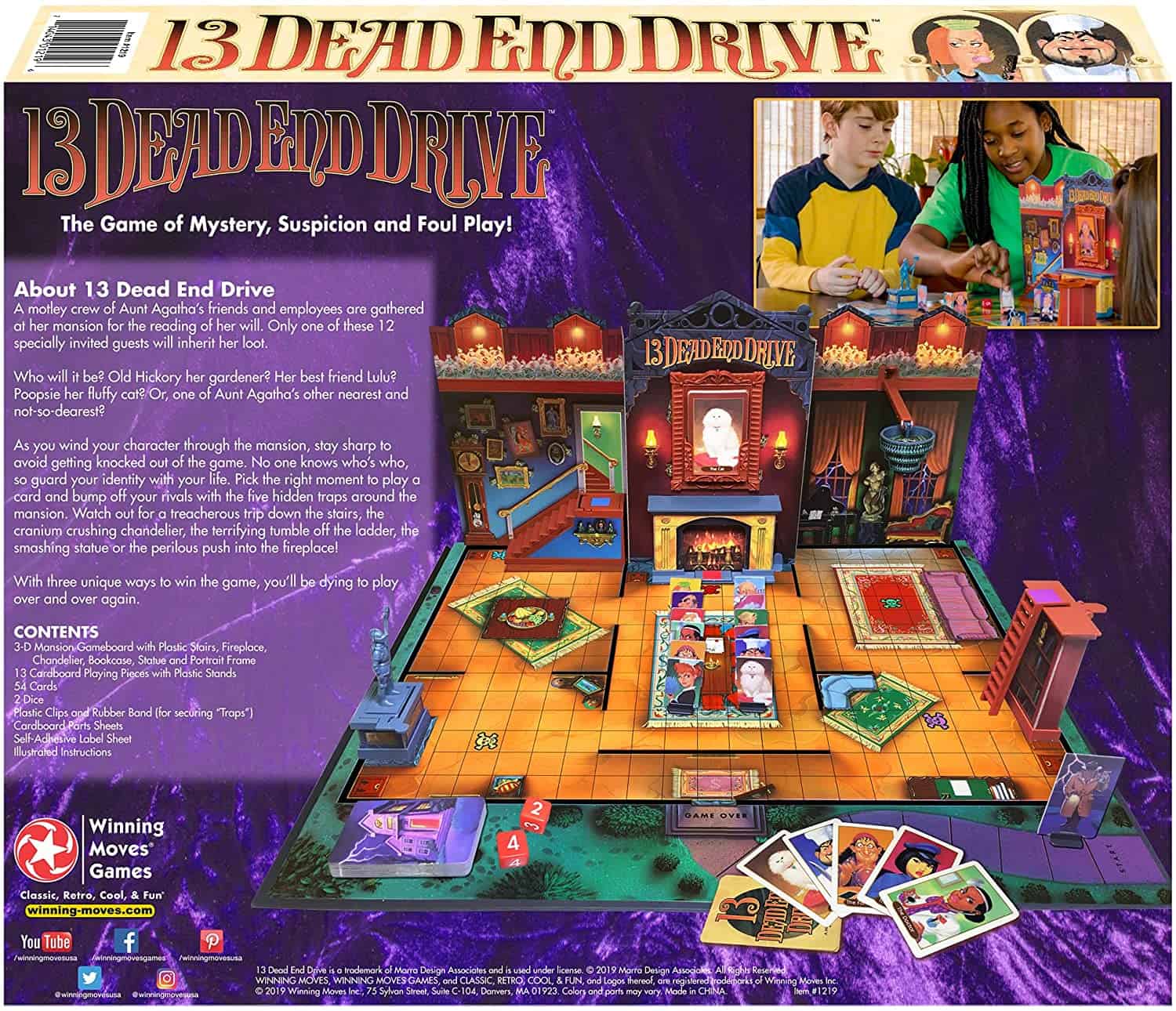
The game comes with clear diagrams which explain how to construct the board. Once you have done this, you’re ready to set up the game and play!
Setup
Here’s how to set up the game in a few easy steps.
- Construct the game board as per the instructions that can be located within the box. All players should face the front of the mansion.
- Remove the Detective pawn and the twelve regular pawns from the cardboard parts sheet, discarding any waste. Each pawn should then be placed into a pawn stand and positioned on a Red Chair starting space.
- Place the Detective pawn on the Start space.
- Separate the card deck into three piles. There should be twenty-nine Trap cards, thirteen Portrait cards, and twelve Character cards.
- Set Aunt Agatha’s portrait card aside, then shuffle the other cards and place them in a pile face down. Next, slide Agatha’s card beneath the deck, then turn it over so her card is on top, facing up.
- Shuffle the three different kinds of Trap cards and place them in a pile face down.
- Likewise, shuffle the twelve Character cards and deal them out (keeping them face down!) according to the number of players.
If there are four players, each one should get three cards; if there are three, each player gets four cards; and if there are two, then each player gets four cards plus two secret character cards each.
Playing the Game
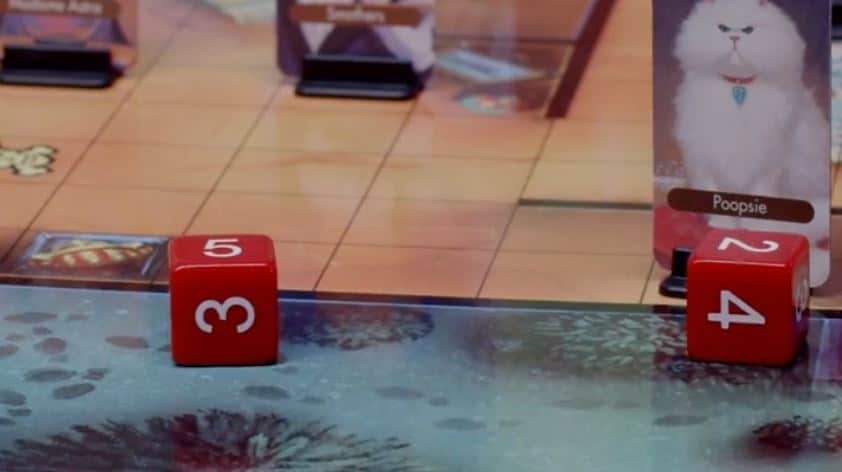
To decide who begins the game, each player needs to roll the dice; the person with the highest number begins the game, and play continues clockwise.
To start, remove Aunt Agatha’s Portrait card from the frame and place it face down on the game board’s sofa. The card that has been revealed is now the favorite to inherit Agatha’s fortune.
As a result, the corresponding pawn must try to get out the front door without being “knocked off” to win. The term “knocked off” refers to being caught in one of the many traps that are hidden around the mansion.
As the game progresses, the portrait will change many times; it’s vital that you time your escape so it happens when your portrait is shown. Otherwise you can’t inherit anything.
Taking a turn
Roll both dice and move two different pawns, one for each die. Pawns have to move the full count of a die roll, so if you roll a three and a five, one must move three spaces and the other five.
You can choose to move any pawns on the game board, not necessarily your own.
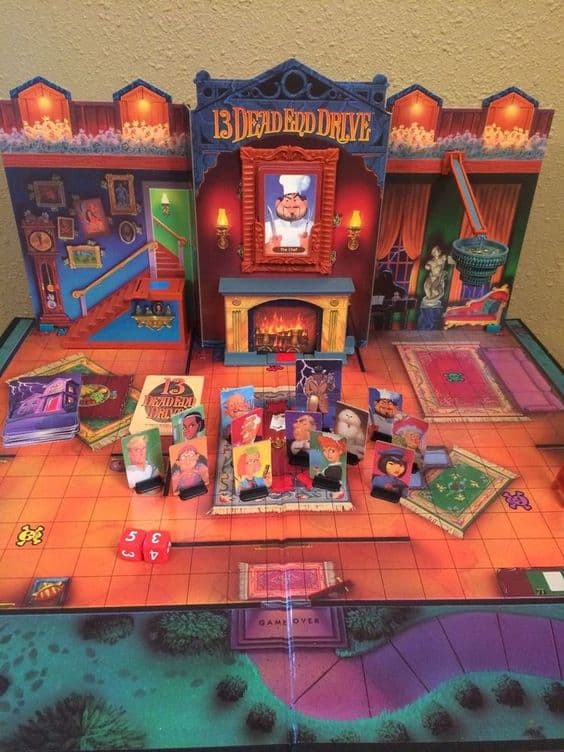
Moving pawns
There are some rules governing how and where pawns can move.
- Each game board square represents one movement. Pawns are able to move horizontally and vertically but not diagonally.
- Before any pawns can be moved a second time or onto a Trap space, all pawns need to have been moved off the Red Chair starting spaces.
- Pawns can’t land on or pass through any space that is already occupied (either by another pawn or an item of furniture).
- Pawns also can’t pass through walls, though they can move over rugs.
Rolling doubles
If you roll doubles, you are permitted to change the portrait. Move the card that is currently shown to the back of the deck and reveal the card underneath. However, there is no obligation to change the portrait; this is entirely optional.
You also have to either move one pawn the total amount of both die or move two pawns, one for each die.
Ending your turn
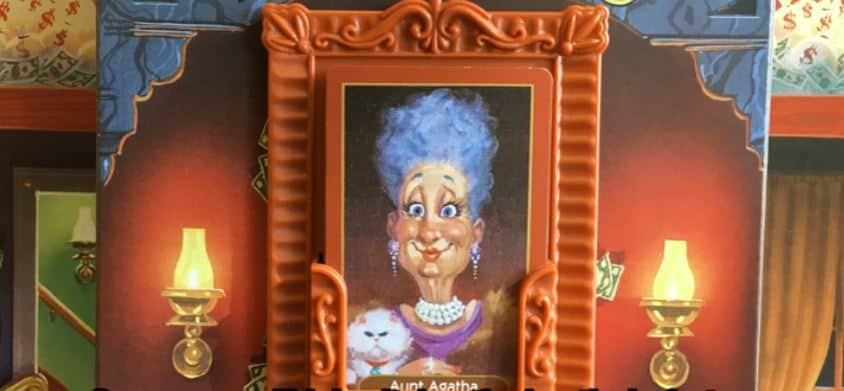
Your turn finishes after you move a pawn or pawns.
If you move onto a Trap space, your turn is completed after you play a Trap card and try to release the trap.
Game board spaces
There are a few special spaces you should be aware of, such as Secret Passage spaces. There are five of these, each with a wooden door. You can use them to move your opponents’ pieces closer to the Trap spaces for which you have the corresponding Trap cards.
Move and spring rules
You can only spring a trap to “knock off” a pawn if you have moved that pawn onto a Trap space during your current turn. Moreover, when you move two pawns on a turn, you must finish all actions for the first pawn before doing anything with the second.
Playing trap cards
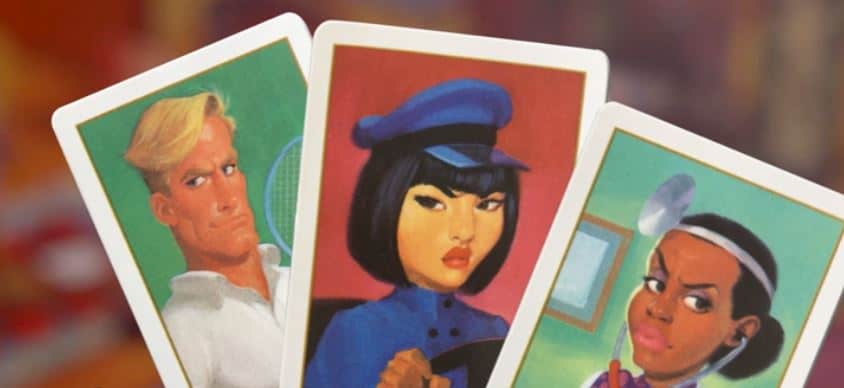
In the event that you have a matching Trap or Wild card in your hand, you can use the card by placing it face up in a discard pile on the front lawn.
However, if you don’t already have the matching card, you can draw one from the pile. If it matches, you can use it to spring the trap; if it doesn’t, then you have to announce that it’s the wrong card.
Drawing a Detective card allows you to move the Detective pawn one space towards the mansion’s front door. After you have done that, draw another card from the Trap card pile.
“Knocked off” pawns
Once a trap has been sprung, the affected pawn is immediately out of play. You can then reset the trap for its next victim.
Springing a trap

Follow these instructions to spring a trap:
- Stairs – move the pawn up the stairs to the blue label and press the lever to fling the pawn back down the stairs.
- Fireplace – move the pawn onto the red label on the trap and push the lever to flip the pawn into the fireplace.
- Chandelier – press the finger lever to release the chandelier.
- Statue – again, pull the finger lever to topple the statue.
- Bookcase – move the pawn up the ladder to the purple label and press the lever to topple it.
Out of the game
A player is out of the game if they lose their last Character card.
Bluffing
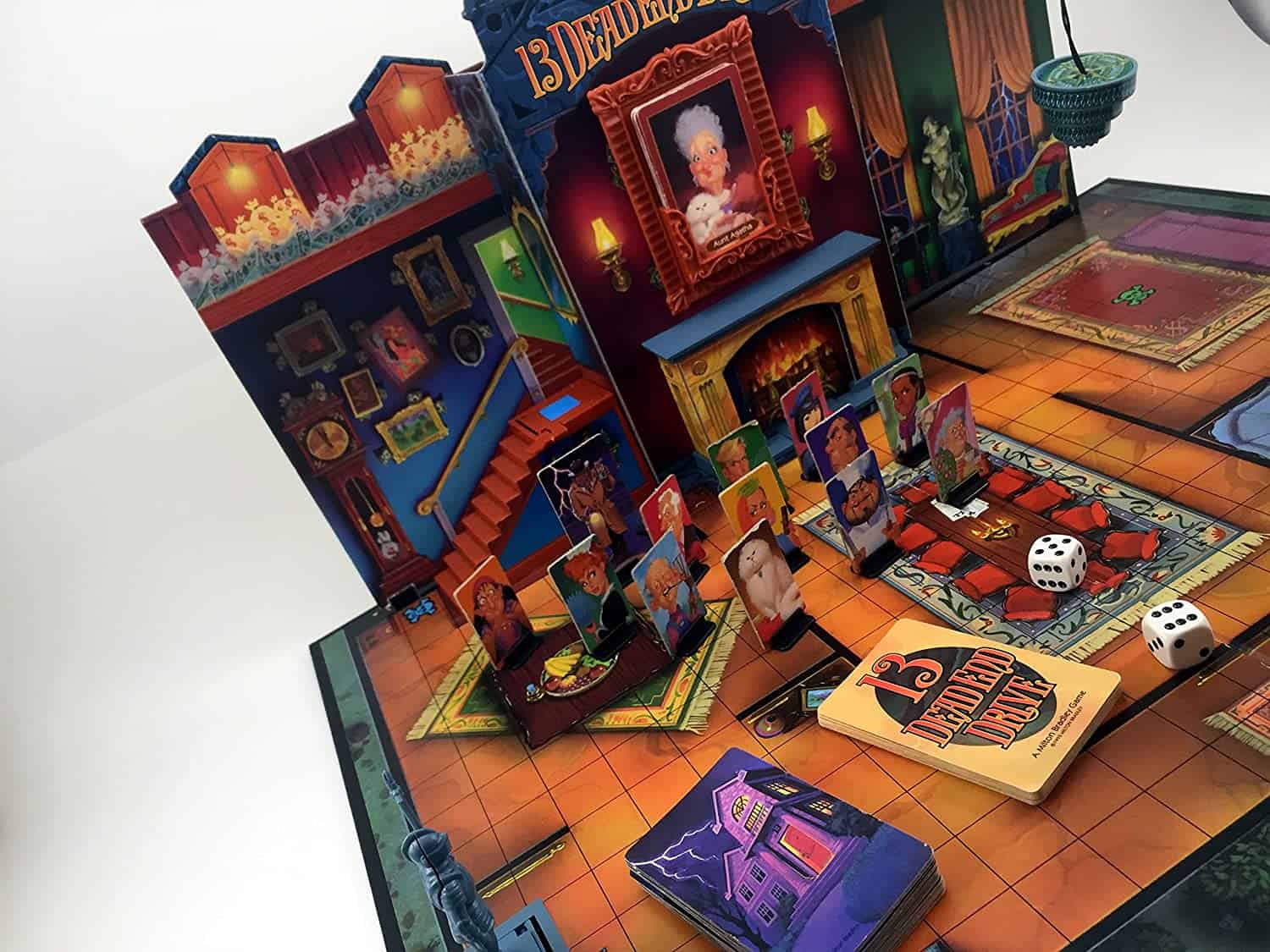
The idea of the game is to keep the identity of your pawn a secret from the other players. As such, you need to bluff by moving pawns that aren’t your own towards the front door of the mansion.
If you’re a pro at bluffing, another game that’s worth trying is The King’s Dilemma (though it should be noted that this game is aimed at a much older audience).
How to win
To win, your pawn needs to leave the mansion and land on the Game Over space when its portrait is hanging on the wall. There are a couple of other ways it’s possible to win too:
- Your pawn is the last one alive
- The Detective pawn reaches the Game Over space when your pawn’s portrait is on the wall
Who is 13 Dead End Drive for?
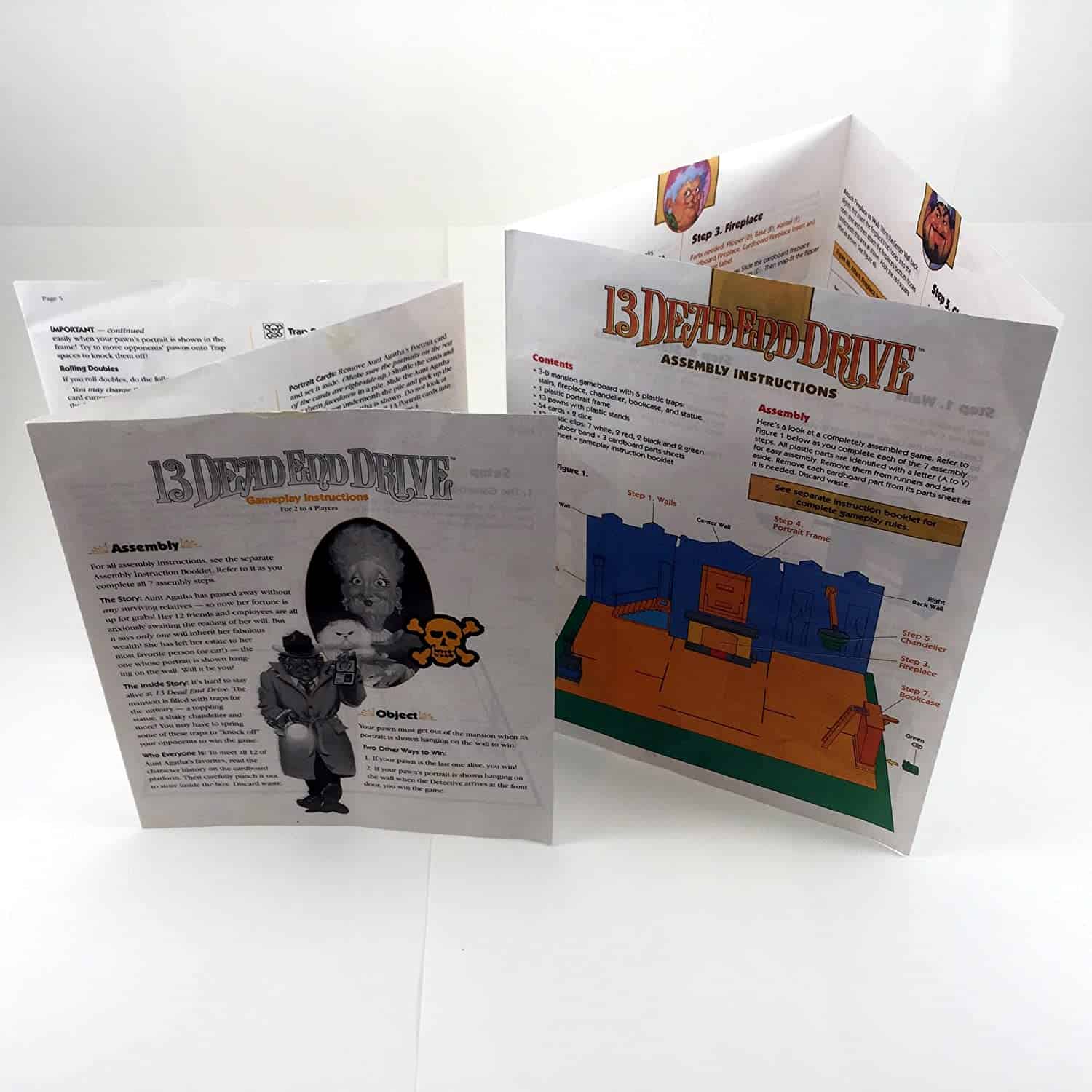
13 Dead End Drive is recommended for two to four players aged nine and above, but the game is actually suitable for children who are younger than that in my opinion.
It’s one of my favorite family games and certainly one of the most fun board games out there. Though there isn’t really any strategy involved other than bluffing, this is enough to make gameplay engaging even for adults.
How Many Pieces are There in 13 Dead End Drive?
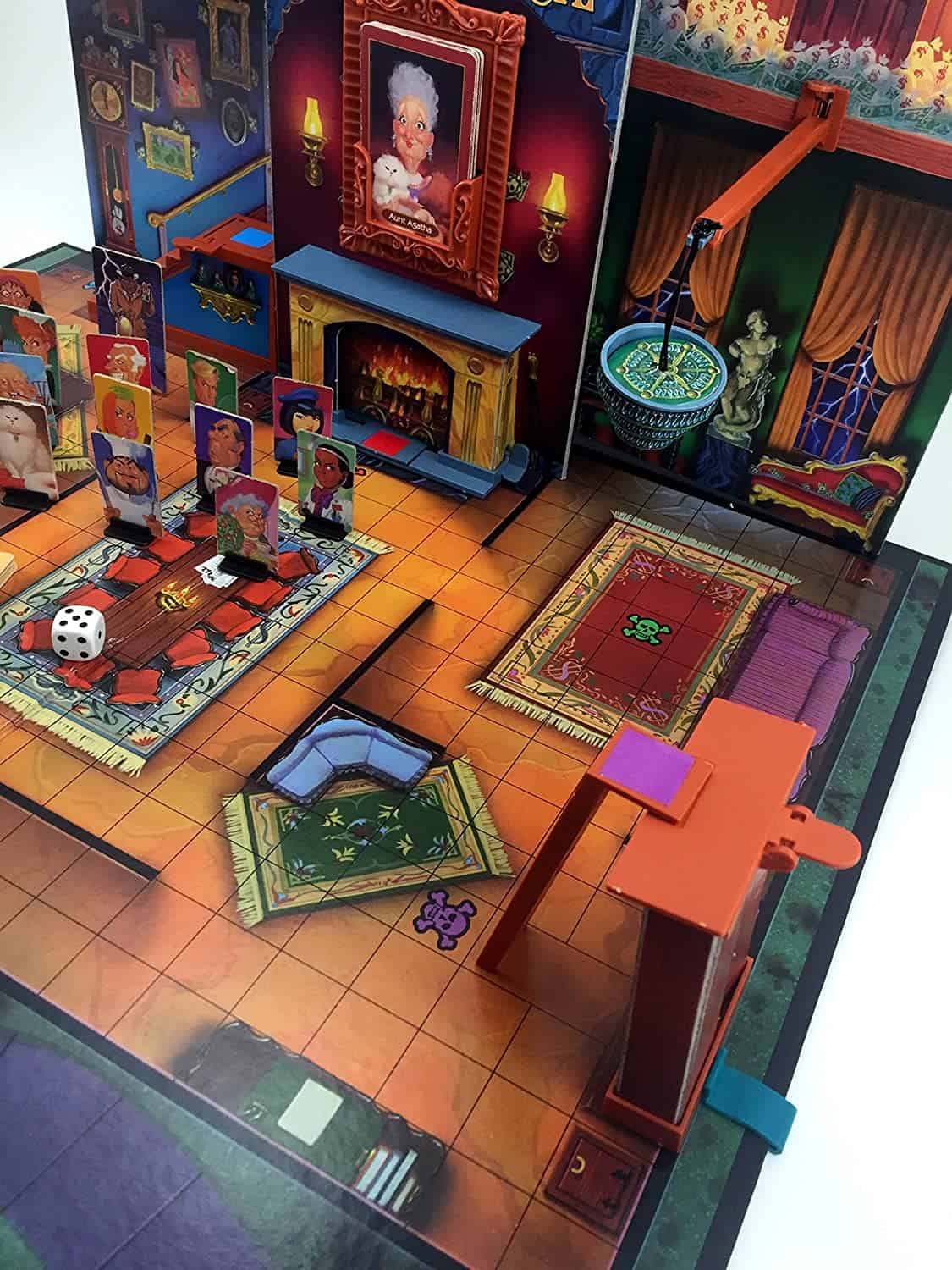
In the box, you can find the following components:
- Rulebook
- Character pop out cards
- Stickers
- Playing cards
- Game board
- 3D room pieces
- Plastic trap pieces
Alternatives to 13 Dead End Drive
Here are a few recommendations for you if you like the sound of 13 Dead End Drive.
Don’t Wake Daddy.
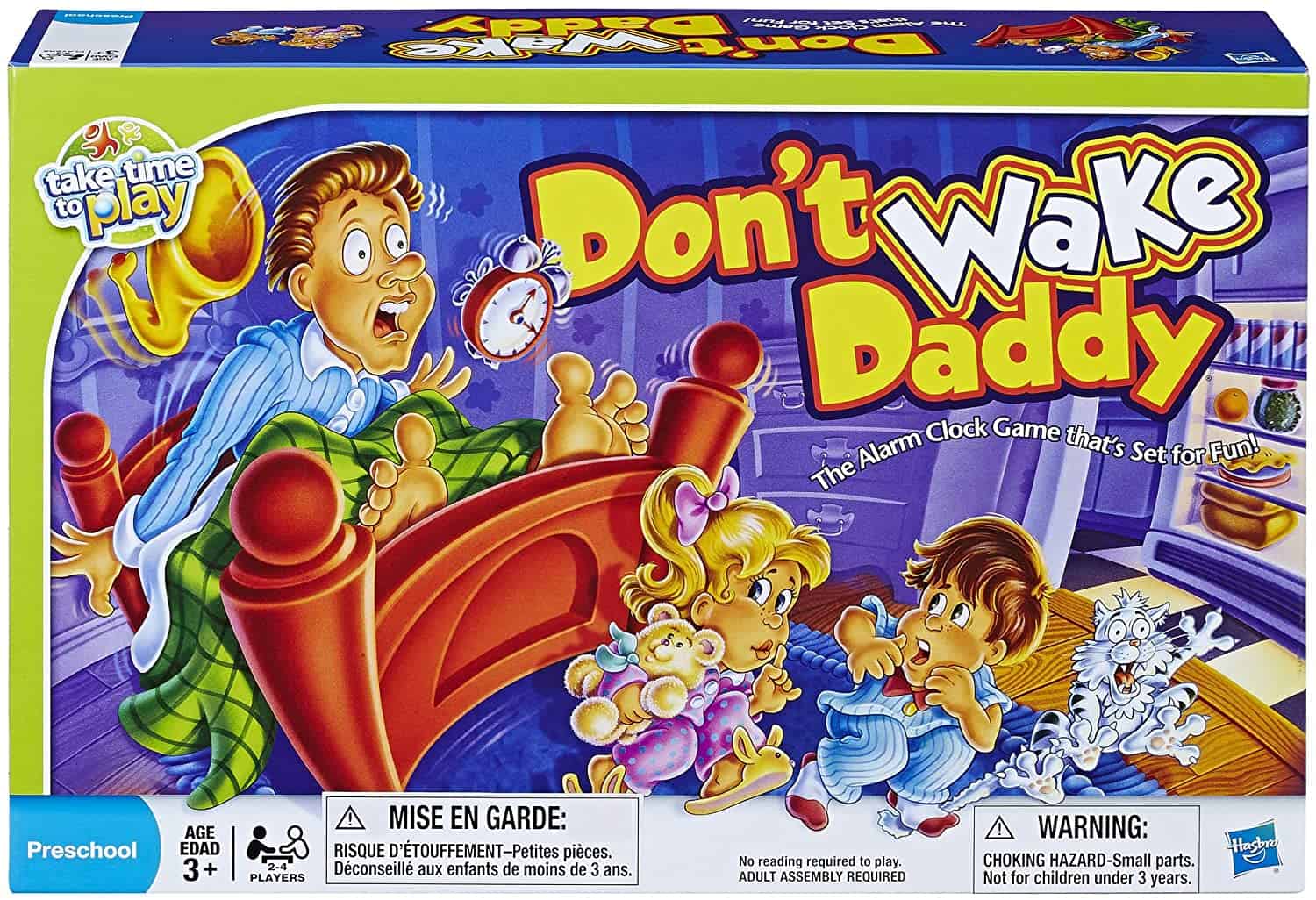
Don’t Wake Daddy definitely has a similar target demographic to 13 Dead End Drive. It’s a firm favorite amongst families, especially those with young kids, to entertain. Both games share a number of common features and are based on a similar premise: players sneak around the house at night hoping to win something if they successfully reach their destination.
You can read our full guide to Don’t Wake Daddy here.
- Players – 2-4
- Recommended age – 3+
- Playing time – 30 minutes
Wahoo

Also known as Aggravation, Wahoo is another board game where pieces move according to the roll of a die. It’s a classic race-around-the-board game where players attempt to get their marbles from base to home.
Want to find out more? Check out our Wahoo board game guide for all the information you need.
- Players – 2-6
- Recommended age – 3+
- Playing time – 20 minutes
Operation

This is a classic children’s game that has brought joy to many generations thanks to its tactile, hands-on gameplay. Operation challenges you to operate on a patient, using tweezers to remove funny ailment parts without touching the sides – if you fail, you’ll be in for a shock as the board begins to buzz!
- Players – 1-4
- Recommended age – 6+
- Playing time – 20 minutes
13 Dead End Drive – Is It Worth Buying?
I’m going to be totally honest. I can’t recommend this game enough! Not only does it combine all the elements you could hope for in the ideal family game – humor, tension, mystery, competition, and heaps of fun – but it also does so in a way that’s visually exciting.
The 3D board ensures there’s never a dull moment in 13 Dead End Drive, especially since there are so many traps lying around just waiting to claim another victim. Add to this the element of bluffing that the game demands, and you have a recipe for hours of fun.
Now you’ve found out just how awesome this game is; you’re probably wondering if there are any other family games out there that are just as good. Well, you’re in the right place! Please read our guide to the best family board games here.
Frequently Asked Questions
Question: Can you play 13 Dead End Drive solo?
Answer: Unfortunately, it isn’t a solo game, but you can play it with two people.
In a two-player game, deal a hand of four Character cards to each player. Next, deal two secret Character cards face down to each player. These cards must be kept face down for the whole game. They can only be revealed if neither player is holding the matching Character card at the end of the game.
However, if you’re set on finding a solo game, we can help with that, too – check out our guide explaining how to find the best solo board games.
Question: Is there a sequel to 13 Dead End Drive?
Answer: The sequel is 1313 Dead End Drive which is based on a similar premise.
Question: Where can I buy 13 Dead End Drive?
Answer: You can purchase the game from Amazon.
Question: Can an eight-year-old play 13 Dead End Drive?
Answer: Yes, this game would be perfect for an eight-year-old.
Recommended reads:
- Catan Junior Guide
- Harry Potter Hogwarts Battle Review and Guide
- How to Find the Best Six Player Board Games
- Stratego Pieces Explained – Must-Know Facts - February 28, 2023
- Wahoo Board Game Guide – AKA Aggravation Guide - February 22, 2023
- Pokemon Monopoly Guide - February 22, 2023

